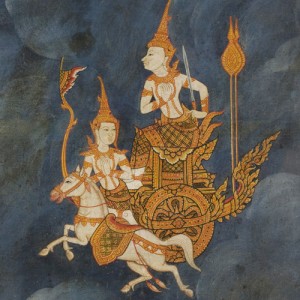
by Sandy | Jan 2, 2010 | Art, Arts, Entertainment and Music, Blogroll, Culture, Museums

In the 19th century, Siam (now Thailand) and Burma (now Myanmar) were neighboring kingdoms. Before they were touched by European imperialism, their traditions of luxurious arts and architecture flourished.
The Asian Arts Museum of San Francisco’s “Emerald Cities is the first major exhibition in the West to explore the rich but little known arts of Siam and Burma from this period. Many of the 140 stunning artworks—including gilded ritual vessels, mother-of-pearl inlaid furniture, colorful paintings, manuscripts, exquisite textiles, delicate ceramics, and more—were recently acquired by the museum from the Doris Duke Charitable Foundation and are on display for the first time.”
“Emerald Cities: Arts of Siam & Burma” * Until January 10, 2010
Asian Art Museum, San Francisco, CA
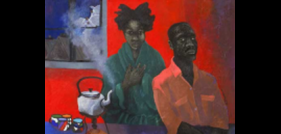
by Bob Martin | Dec 28, 2009 | Artist, Culture, Theater

Le pont / Bamako / Mali / 2008 by Joel Andrianomearisoa
The Herzliya Museum of Contemporary Art opening reception January 9th of “A Collective Diary:
An African Contemporary Journey”, featuring the work of 12 African contemporary artists.
Art always captures the truth, as it is witnessed by the artist. There is no attempt to conceal. This exhibit is a part of a group show that has been traveling the world and displays Africa’s cultural diversity in its art and thinking.
[ad#Adsense Link Unit]
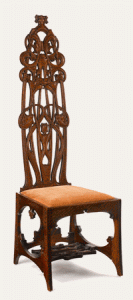
by Sandy | Dec 24, 2009 | Art, Blogroll, Culture, Exhibits, Museums
 One of the exhibits at the Dallas Museum of Art is “The Artistic Furniture of Charles Rohlfs”. “Charles Rohlfs (1853–1936) called his unprecedented designs “artistic furniture.” His unusually inventive forms and imaginative carving combined many different influences, from the abstract naturalism of art nouveau styling to boldly direct forms characteristic of the Arts and Crafts movement.”
One of the exhibits at the Dallas Museum of Art is “The Artistic Furniture of Charles Rohlfs”. “Charles Rohlfs (1853–1936) called his unprecedented designs “artistic furniture.” His unusually inventive forms and imaginative carving combined many different influences, from the abstract naturalism of art nouveau styling to boldly direct forms characteristic of the Arts and Crafts movement.”
“The Artistic Furniture of Charles Rohlfs”- Until January 3, 2010
Dallas Museum of Art
1717 North Harwood, Dallas, Texas
BTW: The “Arts and Crafts Movement” blossomed in the last years of the 19th century and the early years of the 20th century – 1880 to 1910. “It began primarily as a search for authentic and meaningful styles for the 19th century and as a reaction to the eclectic revival of historic styles of the Victorian era and to “soulless” machine-made production aided by the Industrial Revolution.” (from Wikipedia)
(Image: Oak Tall-Back chair, 1899)
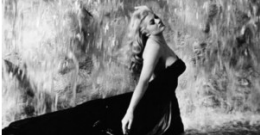
by Bob Martin | Dec 22, 2009 | Art, Culture, Movies, Museums
Fellini is seen as a puppeteer, a sort of Jim Henson, who demanded complete control

Federico Fellini
over his actors and anything else that had to do with his movies was truly an artist with a canvas that was in motion. What I take away from watching his movies was his honesty. Although movies like “8 &1/2” and “Juliet of the Spirits” are filled with dream or mystical sequences, it is impossible to escape Fellini’s truthfulness.
Fellini contributed to an unnamed movement that had us all thinking about film differently. He stoked up our imagination a bit.
An exhibit at the Jeu de Paume “Fellini, la Grande Parade” ends January 17th 2010 and for those of us who celebrate the coming of the New Year in Paris, seeing this exhibit might be a great way to bring in the year.
[ad#Adsense Link Unit]
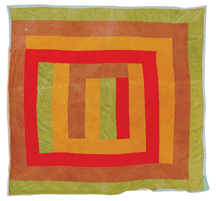
by Sandy | Dec 18, 2009 | Art, Blogroll, Culture, Exhibits, Museums
There is a great exhibit that has been traveling around the country, museums, churches, community houses, for the past several years – “The Quilts of Gee’s Bend”. In 2010 it will visit the Nevada Museum of Art in Reno.

The quilts were sewn by the women of a small Alabama community. Beginning more than 60 years ago, they created works of art out of worn dresses, old jeans, and scraps of cloth. They may have been made for warmth, but their beauty couldn’t help but be noticed and appreciated.
Some have described them as primitive, but when the quilts are lined up on a wall, it becomes apparent that the women pored so much of themselves into the work and took such pride in their craft, the art is stunning. The use of color, shapes and a loving attention to pattern and design, make these quilts very sophisticated in their simplicity.
Go see them if you get the chance.
“A Survey of Gee’s Bend Quilts” – February 06, 2010 – April 11, 2010
Nevada Museum of Art
Donald W. Reynolds Center for the Visual Arts
160 West Liberty Street, Reno NV
(Images: “Medallion”, Flora Moore, 1970 and quilt by Loretta Pettaway, 1960)

by Bob Martin | Dec 8, 2009 | Art, Books, music
Listening today to Robin D.G. Kelly on Fresh Air speak about his new book

Thelonious Monk
“Thelonious Monk: The Life and Times of an American Original” and about Monk’s dancing in a circle. Kelly says that Monk was actually leading the rhythm section of the band or quartet when he got up from the piano and started to rotate.
I’ve seen Monk a few times at the Randall’s Island Jazz Festival and at New York Town Hall and remember the dancing and not finding it strange at the time and I never got he was doing anything other having a good time. I’ll take Kelly’s research in writing this book as fact and I did not see it that way at the time. Monk’s dancing only got strange when he started to do the dance when not on stage.
Monk’s repetitive movements could have been a sign of autism and here again Kelly dismisses this completely. I think we will never really know sure. The book sounds like a good read and present for the holidays.
[ad#Adsense Link Unit]












